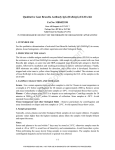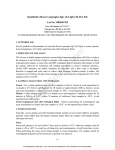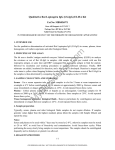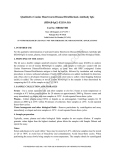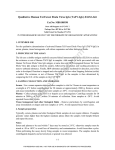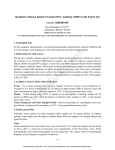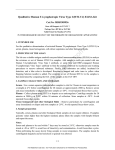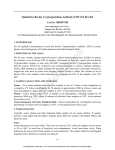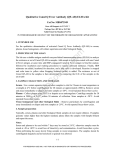Download MyBioSource.com
Transcript
Human Leptospira IgG (LEBTOSPIRA IgG) ELISA Kit Cat.No: MBS036135 Store All Reagents At 2-8°C ! Package Size: 96 T/Kit Valid Period: Six Months (2-8°C) For Samples: Serum, Plasma, Tissue Homogenate, Feces, Urine and Body Fluids FOR RESEARCH USE ONLY! om NOT FOR THERAPEUTIC OR DIAGNOSTIC APPLICATIONS! So ur ce .c INTENDED USE For the qualitative determination of activated Human Leptospira IgG, LEBTOSPIRA IgG-Ab in serum, plasma, tissue homogenate, cell culture supernates and other biological fluids. For Research use only and is not for use in diagnostic or therapeutic procedures. If you have any questions, please contact us. yB io PRINCIPLE OF THE ASSAY The kit uses a double‐antigen sandwich enzyme‐linked immunosorbent assay (ELISA) to analyze the existence or not of Human LEBTOSPIRA IgG-Ab in samples. Add sample to wells pre‐coated with one Human Leptospira IgG at same time add HRP‐conjugated Human Leptospira IgG antigen to bind the analyte, followed by incubation and washing procedures to remove unbound substance. Finally, HRP substrates are added, incubated for detection, and a blue color is developed. Reaction is stopped and color turns to yellow when Stopping Solution (acidic) is added. The existence or not of Human LEBTOSPIRA IgG-Ab in the samples is then determined by comparing the O.D. of the samples to the CUT OFF. M SAMPLE COLLECTION AND STORAGES Serum - Use a serum separator tube and allow samples to clot for 2 hours at room temperature or overnight at 4°C before centrifugation for 20 minutes at approximately 2000×g. Remove serum and assay immediately or aliquot and store samples at -20°C. Avoid repeated freeze-thaw cycles Plasma - Collect plasma using EDTA or heparin as an anticoagulant. Centrifuge samples for 30 minutes at 2000×g at 2-8°C within 30 minutes of collection. Store samples at -20°C. Avoid repeated freeze-thaw cycles. Tissue homogenate and other biological fluids - Remove particulates by centrifugation and assay immediately or aliquot and store samples at -20°C. Avoid repeated freeze-thaw cycles. Sample preparation - Typically, serum, plasma and other biological fluids samples do not require dilution. If samples generate values higher than the highest standard, please dilute the samples with Sample Diluent and repeat the assay. Notes: Serum and plasma to be used within 7 days may be stored at 2-8°C, otherwise samples must be stored at -20 or -80°C to avoid loss of bioactivity and contamination. Avoid freeze-thaw cycles. When performing the assay slowly bring samples to room temperature. The samples shoule be centrifugated dequately and no hemolysis or granule was allowed. 1/3 FOR RESEARCH USE ONLY. NOT FOR USE IN DIAGNOSTIC OR THERAPEUTIC PROCEDURES. REAGENTS PROVIDED All reagents provided are stored at 2-8°C. Refer to the expiration date on the label. 96 Tests 48 Tests 1 Microelisa stripplate 12*8strips 12*4strips 2 Positive Control 0.5ml/vial 0.5ml/vial 3 Negative Control 0.5ml/vial 0.5ml/vial 4 Sample diluent 10ml 10ml 5 HRP-Conjugate reagent 10ml 5.0ml 6 20X Wash solution 25ml 15ml 7 Chromogen Solution A 6.0ml 3.0ml 8 Chromogen Solution B 6.0ml 3.0ml 9 Stop Solution 6.0ml 3.0ml 10 Closure plate membrane 2 11 User manual 1 12 Sealed bags 1 om Materials 2 .c 1 1 So ur ce Items yB io MATERIALS REQUIRED BUT NOT SUPPLIED 1. Standard microplate reader capable of measuring absorbance at 450 nm 2. Automated Washing 3. 37°C incubator 4. Clean tube and Eppendorf tube 5. Distilled or deionized water 6. Precision pipettes, disposable pipette tips, multi-channel pipettes and Absorbent paper M PRECAUTIONS 1. The operation should be carried out in strict accordance with the provided instructions. 2. To preserve unused strip-wells, it should be stored in the sealed bag. 3. Always avoid foaming when mixing or reconstituting protein solutions. 4. Pipette reagents and samples into the center of each well. 5. The samples should be transferred into the assay wells within 15 minutes of dilution. 6. We recommended that all standard, testing samples are tested in duplicate to minimize the test errors. 7. If the blue color too shallow after 15 minutes incubation with the substrates, it may be appropriate to extend the incubation time. 8. Avoid cross‐contamination by changing tips, using separate reservoirs for each reagent, avoid using the suction head without extensive wash. 9. Do not mix the reagents from different batches 10. Stop Solution should be added in the same order of the Substrate solution. 11. Chromogenic Substrate B is light-sensitive, please avoid prolonged exposure to light. 12. The kit should be kept at 2-8°C and cannot be used after expiration date. The standards should be kept at -20°Cafter receiving. 2/3 FOR RESEARCH USE ONLY. NOT FOR USE IN DIAGNOSTIC OR THERAPEUTIC PROCEDURES. WASHING METHOD Manual Washing - Remove incubation mixture by aspirating contents of the plate into a sink or proper waste container. Using a squirt bottle, fill each well completely with Wash Solution (1X), then aspirate contents of the plate into a sink or proper waste container. Repeat this procedure for a total of four times. After final wash, invert plate, and blot dry by hitting plate onto absorbent paper or paper towels until no moisture appears. Note: Hold the sides of the plate frame firmly when washing the plate to assure that all strips remain securely in frame. Automated Washing - Aspirate all wells, then wash plates four times using Wash Solution (1X). Always adjust your washer to aspirate as much liquid as possible and set fill volume at 350µL/well/wash. After final wash, invert plate, and blot dry by hitting plate onto absorbent paper or paper towels until no moisture appears. REAGENT PREPARATION AND STORAGE Wash Solution (1X) - Dilute 1 volume of Wash solution (20X) with 19 volumes of deionized or distilled water. Wash Solution is stable for 1 month at 2-8°C. yB io So ur ce .c om ASSAY PROCEDURE 1. First, secure the desired number of coated wells in the holder. Remove excess microplate strips from the plate frame, return them to the foil pouch containing the desiccant pack, and reseal. 2. Set Positive Control wells, Negative Control wells and testing sample wells on the assay plate/strip. Add Positive Control 50µl, then add Negative Control 50µl to corresponding wells. Add testing sample 10µl then add Sample Diluent 40µl to testing sample wells. 3. Add 100µl of HRP-conjugate reagent to standard wells and sample wells except the blank well, cover with an adhesive strip and incubate for 60 minutes at 37°C. 4. Wash the Microtiter Plate 4 times.(See WASHING METHOD) 5. Add chromogen solution A 50µl and chromogen solution B 50µl to each well. Gently mix and incubate for 15 minutes at 37°C. Protect from light. 6. Add 50µl Stop Solution to each well. The color in the wells should change from blue to yellow. If the color in the wells is green or the color change does not appear uniform, gently tap the plate to ensure thorough mixing. 7. Read the Optical Density (O.D.) at 450 nm using a microtiter plate reader within 15 minutes. M DETERMINE THE RESULT 1. Test validity: the average of Positive control well≥1.00; the average of Negative control well ≤0.15. 2. Calculate Critical (CUT OFF): Critical= the average of Negative control well + 0.15. 3. Negative Result: sample OD< Calculate Critical (CUT OFF) is Negative. 4. Positive Result: sample OD≥ Calculate Critical (CUT OFF) is Positive. ASSAY CHARACTERISTICS 1. Intra-assay CV (%) and Inter-assay CV (%) are less than 15%. 2. Cross-reactivity: This assay recognizes recombinant and natural Human LEBTOSPIRA IgG-Ab. No significant cross-reactivity or interference was observed. 3. Storage: 2-8°C (Use frequently); six months (-20°C). 3/3 FOR RESEARCH USE ONLY. NOT FOR USE IN DIAGNOSTIC OR THERAPEUTIC PROCEDURES.



